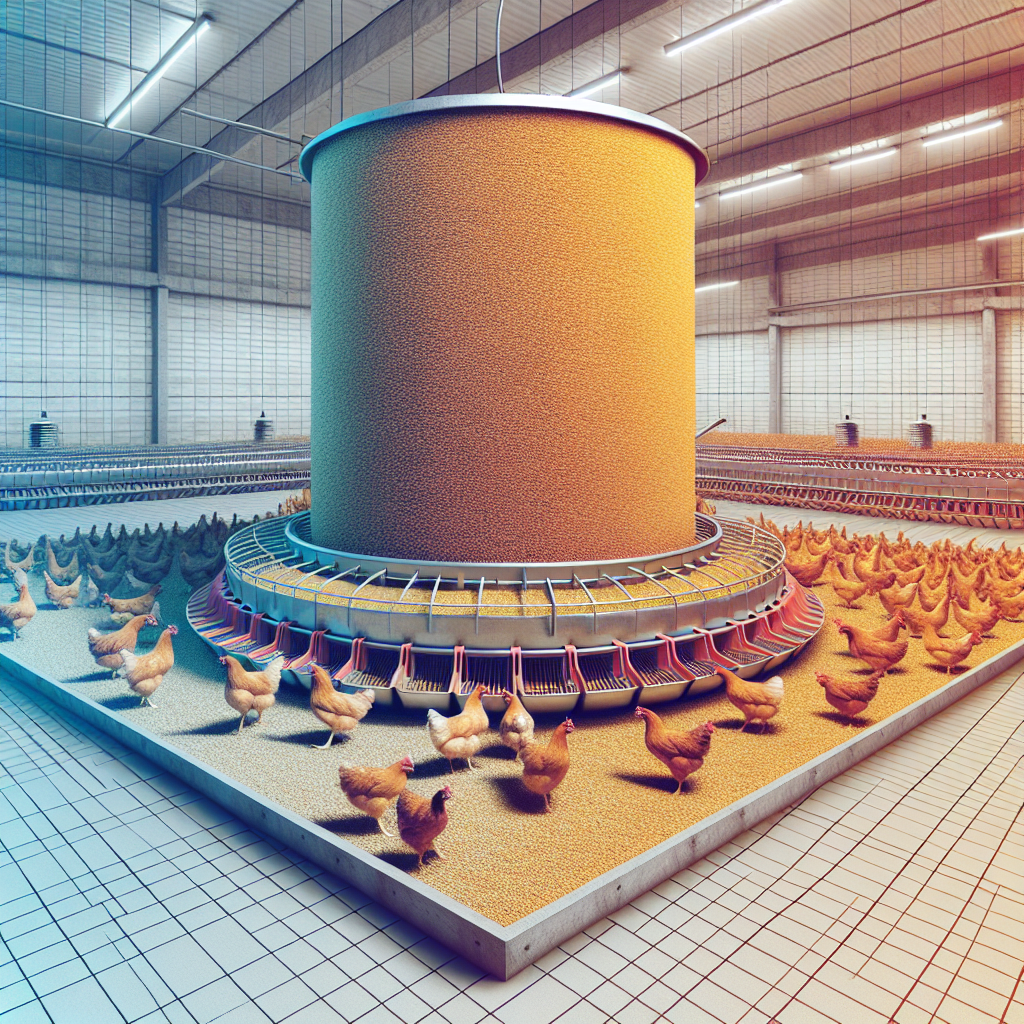Are you a chicken owner looking for practical tips on how to provide enough space for all your feathered friends to access food and water? If so, this article is just for you! Ensuring that each chicken has proper access to feed and water is crucial for their health and well-being. From creating designated feeding and watering stations to implementing smart spacing techniques, we’ll explore a variety of effective methods to ensure that your chickens have the space they need to dine and drink in peace. So, let’s dive right in and discover how you can make your backyard flock even happier and healthier!
Providing Adequate Space for Chickens
Determining the Number of Chickens
When planning to provide adequate space for your chickens, the first step is to determine the number of chickens you will be keeping. This will largely depend on your needs and the purpose of keeping chickens. Are you raising them for eggs or meat production, or simply as pets? Once you have a clear idea of the number of chickens you want, you can move on to calculating the space requirement.
Calculating the Space Requirement
Chickens require a certain amount of space to ensure their well-being and prevent overcrowding. As a general guideline, each chicken should have at least 4 square feet of space in the chicken coop. This measurement includes both the indoor and outdoor area. Therefore, if you have 5 chickens, you will need a minimum of 20 square feet of space. Keep in mind that this is a minimum requirement, and providing more space is always beneficial for the overall health and happiness of your chickens.
Considering the Breed Size
Different chicken breeds have different size requirements. Larger breeds, such as Orpingtons or Brahmas, will naturally need more space compared to smaller breeds, like bantams. It’s important to research the specific breed you are planning to keep and consider their space needs accordingly. Providing adequate space for your chickens will help prevent stress, injuries, and the spread of diseases.
Providing Sufficient Space for Roaming
Chickens are naturally active animals that enjoy roaming and exploring their surroundings. In addition to the space inside the chicken coop, it is important to provide them with outdoor space for their physical and mental well-being. This can be in the form of a chicken run or access to a fenced-in yard. Aim to provide a minimum of 10 square feet per chicken for the outdoor area. This will give them ample space to scratch, dust bathe, and enjoy the fresh air.
Designing a Feeding Area
Choosing Suitable Feeders
When it comes to designing a feeding area for your chickens, choosing the right feeders is essential. There are various types of feeders available, including trough feeders, hanging feeders, and automatic feeders. Consider the size and age of your chickens when selecting feeders. Make sure they have easy access to the feed and that it is kept clean to minimize the risk of contamination.
Calculating the Number of Feeders
To ensure that all your chickens have equal access to feed, it is important to calculate the number of feeders you will need. As a general rule, provide one linear inch of feeder space per chicken. For example, if you have 10 chickens, you will need a minimum of 10 inches of feeder space. This will prevent overcrowding around the feeders and make sure each chicken gets their fair share of food.
Placing the Feeders Strategically
The placement of the feeders is also crucial. They should be positioned in a way that is easily accessible to all chickens but also protects the feed from contamination. Ideally, elevate the feeders off the ground to prevent chickens from scratching bedding or droppings into the feed. Additionally, consider placing the feeders in a well-lit area away from high traffic areas to reduce stress and competition during feeding time.
Creating Water Access
Determining the Number of Waterers
Water is an essential element for the health and well-being of your chickens. To ensure adequate water access, you need to determine the number of waterers required. As a general guideline, provide one waterer per 5-10 chickens. This will ensure that all chickens have access to fresh water at all times. It is important to note that during hot weather or high-intensity egg production, chickens may consume more water, so it is better to err on the side of providing more waterers.
Ensuring Clean and Fresh Water
Clean and fresh water is crucial for the health of chickens. Waterers should be cleaned regularly to prevent the buildup of bacteria or algae. Provide fresh water daily and check waterers throughout the day to ensure they are not contaminated or running low. Bacteria can quickly multiply in stagnant water, so it is important to keep the water clean and replace it as needed.
Positioning Waterers Correctly
The position of waterers is as important as their cleanliness. Place waterers at a comfortable height for chickens to access without straining their necks. Avoid placing them directly on the ground, as this can lead to dirt, droppings, and bedding getting into the water. Instead, use a raised platform or suspend the waterers at an appropriate height. This will help keep the water clean and prevent the risk of bacterial contamination.
Managing Feeding and Watering Routines
Establishing a Schedule
Consistency is key when it comes to feeding and watering routines for chickens. Establishing a schedule helps maintain order and ensures that all chickens have equal access to food and water. Feed your chickens at the same times each day, and make sure they have access to fresh water at all times. This routine will help your chickens develop a sense of security and reduce stress or competition during feeding and watering times.
Monitoring Feed and Water Intake
Regularly monitoring the feed and water intake of your chickens is important to ensure they are receiving adequate nutrition and hydration. Keep an eye on their behavior and appetite. If any chicken appears to be showing signs of reduced appetite or dehydration, it may indicate a health issue or a problem with the feeding and watering routine. Make adjustments as needed and consult with a poultry expert if necessary.
Addressing Overcrowding and Bullying
Overcrowding in the coop or around the feeders and waterers can lead to stress, aggression, and bullying among chickens. It is important to address overcrowding issues by providing sufficient space and multiple feeders and waterers. Observing the behavior of your chickens during feeding and watering times will help you identify any bullying or aggressive behavior. If necessary, separate any chickens that are consistently being targeted to ensure their well-being and safety.
Optimizing the Environment for Chickens
Ensuring Adequate Ventilation
Proper ventilation is essential for maintaining a healthy environment inside the chicken coop. Good air circulation helps remove moisture, ammonia, and odors, which can contribute to respiratory issues and the spread of diseases. Provide vents or windows that can be opened and closed as needed to regulate airflow. It is important to strike a balance between ventilation and protecting your chickens from drafts, especially during colder months.
Controlling Temperature and Humidity
Maintaining an optimal temperature and humidity level is crucial for the well-being of chickens. Extreme temperatures can be harmful to their health, leading to heat stress or frostbite. Provide insulation and ventilation to help regulate the temperature inside the coop. Monitoring humidity levels is equally important, as high humidity can contribute to the growth of mold and bacteria. Use bedding materials that absorb moisture and regularly clean and replace wet bedding.
Creating Comfortable Laying Areas
If you are keeping chickens for egg production, it is important to provide comfortable and clean laying areas. Nest boxes should be designed with appropriate dimensions and lined with clean bedding to provide a comfortable space for chickens to lay their eggs. Aim to provide one nest box for every 4-5 hens. Regularly collect eggs to prevent broodiness and to ensure the cleanliness and quality of the eggs.
Utilizing Outdoor Space
Providing Access to Outdoor Runs
Chickens thrive when they have access to outdoor spaces where they can engage in natural behaviors such as scratching, foraging, and sunbathing. Establish an outdoor run or fenced-in yard where your chickens can safely roam during the day. The outdoor space should be securely fenced to protect the chickens from predators and should provide shade, shelter, and areas for dust bathing.
Rotating Pasture Areas
To optimize the use of outdoor space and provide fresh grazing opportunities, consider rotating the pasture areas available to your chickens. By periodically moving their outdoor run or utilizing portable fencing, you can ensure that the chickens have access to fresh grass and insects. This also helps prevent the buildup of pests and diseases in a specific area and promotes a healthier environment for your chickens.
Offering Natural Foraging Opportunities
Chickens are natural foragers and enjoy searching for food in their environment. To satisfy their natural instincts and provide mental stimulation, offer natural foraging opportunities in the outdoor space. Scatter treats or food items for chickens to discover, or create a “no-dig garden” area where they can scratch and find insects. This encourages natural behavior and helps keep your chickens active and engaged.
Considering Transitional Space
Implementing Segregated Areas
Transitional spaces are important when introducing new chickens or separating chickens for various reasons, such as illness or injury. Implementing segregated areas within the coop or utilizing temporary chicken tractors can help facilitate a smooth transition. This allows new chickens to acclimate to the existing flock gradually, reducing the risk of aggression and the spread of diseases. Segregated areas also provide a safe space for vulnerable or injured chickens to recover.
Introducing Chickens to New Spaces
When introducing chickens to new spaces, such as the outdoor run or a different coop, it is important to do so gradually. Allow chickens to explore and adjust to the new environment at their own pace. Initially, supervise their interactions to ensure they are adapting well and not exhibiting signs of stress or aggression. Providing treats and distractions can help alleviate any tensions during the transition period.
Monitoring Integration and Hierarchies
Integration of new chickens into an existing flock can sometimes be challenging, as establishing a pecking order is natural chicken behavior. It is important to closely monitor their interactions during the integration process. Watch for excessive aggression or bullying, and be ready to intervene if necessary. Monitoring the flock’s dynamics will help ensure a harmonious and cohesive group, minimizing stress and injuries.
Minimizing Any Health Risks
Implementing Biosecurity Measures
Biosecurity measures are essential to minimize the risk of disease outbreaks among your chickens. Implement a strict plan to prevent the introduction and spread of diseases. This includes limiting visitors to the coop, regularly disinfecting equipment, and quarantining new birds before introducing them to the existing flock. It is also important to monitor and control pests, such as rodents or wild birds, as they can introduce diseases to your flock.
Preventing Contamination and Disease Spread
Maintaining a clean and hygienic environment is crucial for the health of your chickens. Regularly clean and disinfect the chicken coop, including nest boxes, perches, and feeders. Remove any wet or soiled bedding promptly, as it can harbor bacteria and promote the spread of diseases. Practice good hygiene yourself by washing your hands thoroughly before and after handling chickens to prevent contamination.
Observing Signs of Illness
Monitoring the health of your chickens on a regular basis is important for early detection of any signs of illness. Familiarize yourself with common chicken diseases and learn to recognize symptoms such as lethargy, loss of appetite, abnormal droppings, or respiratory issues. Promptly isolate any sick or injured chickens and seek veterinary advice if needed. Taking immediate action can prevent the spread of diseases and improve the chances of recovery.
Seeking Professional Advice
Consulting with Poultry Experts
If you are new to raising chickens or facing specific challenges, seeking professional advice from poultry experts can be highly beneficial. They have the knowledge and experience to provide guidance on various aspects of chicken care, including housing, nutrition, health, and management. Consult with a local poultry expert or veterinarian for personalized recommendations and solutions to any concerns you may have.
Joining Local Poultry Associations
Joining local poultry associations or clubs is a great way to connect with other chicken enthusiasts and gain valuable insights. These organizations often provide access to resources, workshops, and educational materials that can help expand your knowledge and improve your chicken-keeping skills. Networking with fellow chicken keepers can also provide a support system and a platform for exchanging ideas and experiences.
Attending Workshops and Seminars
Attending workshops and seminars focused on poultry care and management can further enhance your understanding of best practices and new advancements in chicken husbandry. These events often feature knowledgeable speakers and offer hands-on learning opportunities. By participating in such events, you can stay up-to-date with the latest information and techniques, enabling you to provide the best possible care for your chickens.
Conclusion
Providing adequate space, feed, and water access for your chickens is crucial for their overall health, well-being, and productivity. Calculating the space requirement, choosing suitable feeders, and ensuring clean and fresh water are essential aspects of creating a comfortable environment for your flock. Managing feeding and watering routines, optimizing the chicken coop’s environment, utilizing outdoor space, and considering transitional areas help promote a harmonious and thriving chicken community. Minimizing health risks and seeking professional advice when needed are additional steps to ensure the welfare of your feathered friends. By implementing these measures, you can create a safe and fulfilling habitat for your chickens, leading to happy, healthy, and productive birds.




